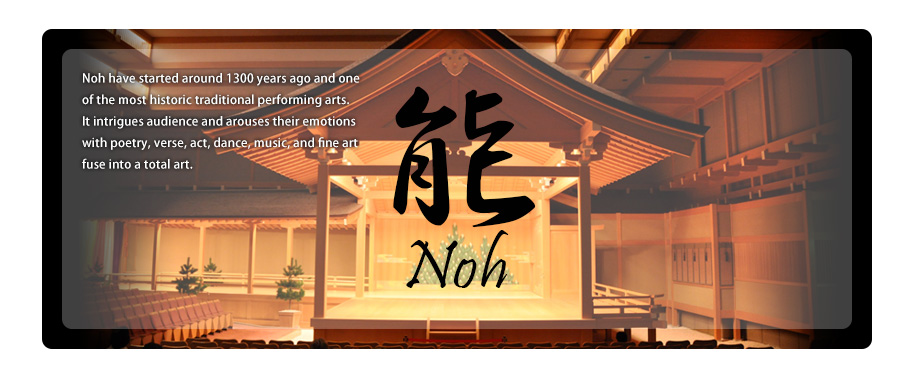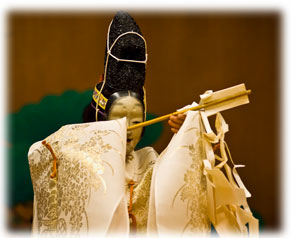
Noh makes infinitely touch emotion with simple stage and actors’ expression.
It continues about 1300 years and representative Japanese traditional art, however it always reborn and renew depends on the audience, which is a living art at the same time.
The almost all of main characters are ghost and they talks looking back about finished life. If it says a ghost perhaps you’ll feel something fearful story but it is not so. The story talks about essential part of human even the era or country are different.

Noh and Kyogen
Kyogen appears almost at the same time as Noh on the history. These two different types art perform as a set. This combination guides you from a world of delicate beauty to a chuckle world. The characters are not a real existed person and the story is based on each period. It uses normal spoken Japanese (easier to understand). As same as Noh, Kyogen sophisticated its expression and it says the Art of comical story.
Originally, Kyogen’s concept came from China and developed totally different from what arrived in Japan at that time.
During the middle age, interspersed laughing to the public and it developed jokes and wisecrack then sophisticated as an art.
Originally, Noh’s concept came from China about 1300 years ago. Noh was called “Sangaku” at that time. And it affiliated with Japanese original culture. About 1000 years ago, Sangaku change its name as “Sarugaku”. It seems like Sarugaku was a short comedy story.
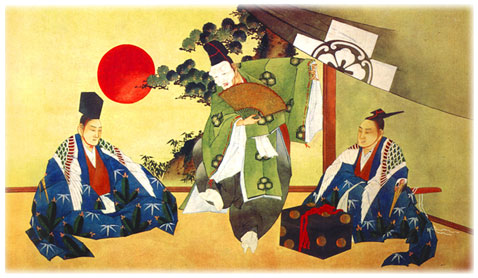 Then in the end of the 13th century (about six hundred years ago), appeared a group and added a proper story element. It is the real origin of Noh.
Then in the end of the 13th century (about six hundred years ago), appeared a group and added a proper story element. It is the real origin of Noh.
In the middle of the 14th century, appears two genius actors “Kanami” and “Zeami”.
The father Kanami add Rhythmical time (like rap music) to the original monotony and made a totally new style music “Kusemai”. And the son “Zeami” changed the performance such as songs and dance to more elegance instead of funny comedy.
The actual Noh was accomplished at that moment. After that Noh actors became employees of power holders and Noh became Samurai class’ general education.
In the end of the 19th century, Noh world confront a huge crisis. But with the effort of Noh masters and the Noh recover its position. In 2001 A.D., UNESCO declared “the masterpiece of intangible heritage of human kind” and registered with other 19 different art and cultures of the world.
The Noh actors was not able to be a women before the World War II, however their number are increasing. Recently, as the result of oversea performance, several foreigners are interested in and taking training.
One of the points to enjoy Noh is its beautiful mask and costume.
The Noh costumes became gorgeous as today was after Edo period. It form which is not expository, abstract Noh costume expand Noh’s expression.
Noh’s costume considers and decides based on the mask first, and then the cloth depends on the music, color, patterns, and the aim.
■Cloth
The Noh cloth can be separate with “Kitsuke”, “Uwagi”, “Hakama”.
An actor put on underclothes them Kitsuke, Hakama and finally Uwagi.For the stage, Noh uses so many clothes and many variation of way to put on makes the difference of “Woman”, “She-devil”, “Old man”, “General Samurai”, etc.
For example, red uses for young woman character and without red uses for matured woman.
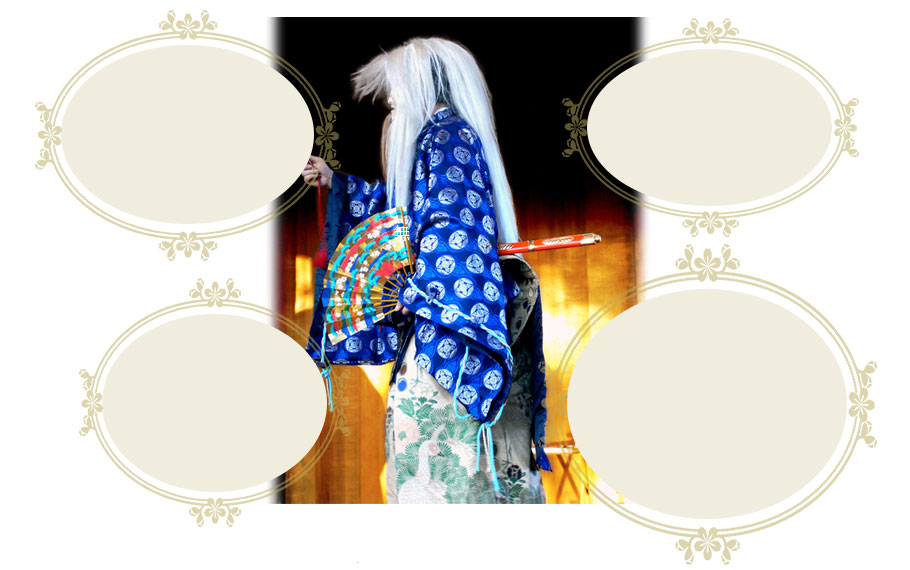
Kitsuke
Surihaku
short sleeve white cloth Kimono of
gold and silver patterns
Nuihaku
short sleeve Kimono of gold, silver, and other with needlework
Atsuita
thick cloth Kimono of
powerful
patterns
Hakama
Ookuchi
strong cloth which widely opens the bottom
Hangiri
imitate with Ookuchi with splendid patterns
Sashinuki
the bottom closes with
string under the knee
Uwagi
Karaori
Short sleeve costume with
colorful patterns
Choken
Wide sleeve costume with braid
Mizugoromo
Thin cloth wide sleeve costume
Prtable tools and
Small items
Portable Tools
Basically, these are the tools carried by the
actors. There are types which the player
carries in they costume and portable tools.
(Stick,Scroll,Paper,Pillow,Fishing Rod)
Small items
It is prepared and it uses variable times
during the stage.
(Folding Fan,Pole Sword,Small Tools,
Ritual Implement,Music
instrumentPail,Basket)
■Mask
The mask which condensed its essence of appeal has an original beauty.
Noh is a kind of masque but not every one is masked. The only main characters have their mask not the others.
It says as the other roles are the real human and the main characters are the inhuman existence.
Comparing with those inhuman existence masks, man and woman mask added later history.
Some story act without mask and the actor acts as he has a mask. It calls “Hitamen”. Of course, he makes up and it is prohibited to change his expression. Kyogen also uses mask sometimes, like “Aikyogen” which act normally between first and second half.
There are more than 200 variations of Noh masks. And it can be classified “old man”, “Samurai”, “woman”, “man”, “vengeful ghost”, and “god”.Introduce some of them.
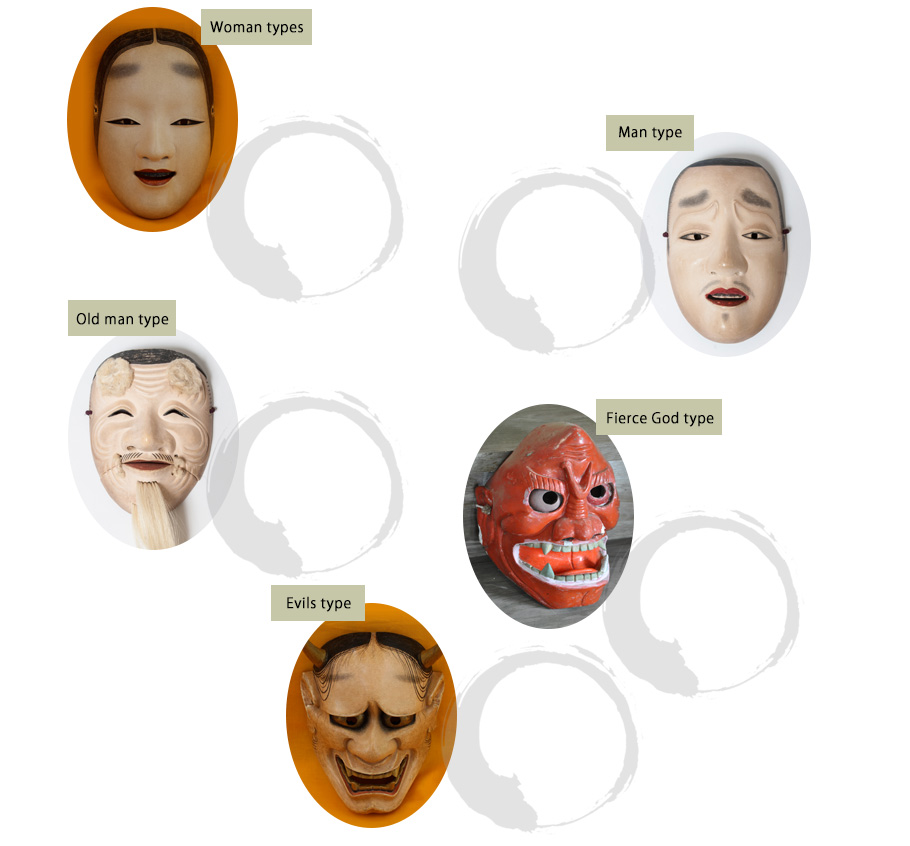
It made with ague expression mask.
It rises up and down the face, express joy and sorrow.
Koomote
One of the representative woman mask. It made as an adolescent young woman.
It uses for a man appears in an imperial court story.
Chujo
It is expressing aristocrats bloom.
It says the mask of a old man was deified as there is a story which a god performed dance borrowed a figure of an old man. There are some shrines which deify the old man mask. It says the mask of an old man is the most historical mask in Noh.
Old man
The mask is separated into two parts and it ties. This characteristic does not have other Noh masks.
Generally, the mask has anger to drive
away the evils and it is expressing
“Tengu” or god
Shikami
The mask of evil devil and it has fierce look of anger. Comparing with woman’s mask, it is expressing more aggressive feelings.
The mask is easy to identify.
Look at the eye of the mask it is bordered with gold and it has strange mood.
Hannya
It is expressing the sadness of woman ghost. Its face is expressing hatred, malice and anger. The horned mask looks more strange and there others too such as “Namanari”, “Ja”, etc.
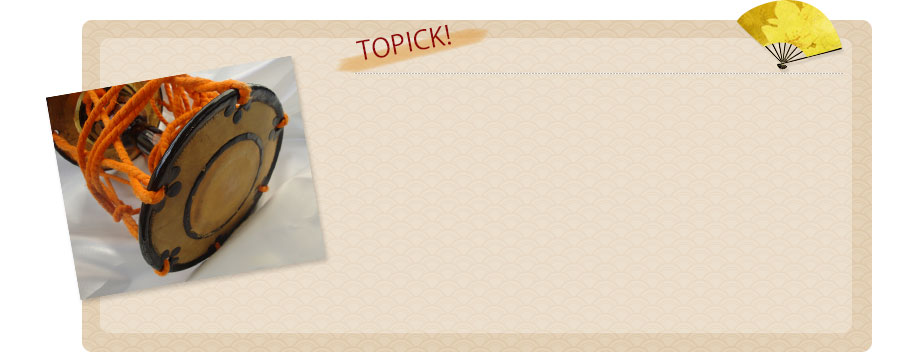
Music in Noh
In the music of Noh there are “Uta”, and “Hyoshi”.
Uta is vacal singing of Noh, and it’s in charge of characters. There is poetry and prose during Noh song. The prose normally does not have music but with certain modulation. The poetry has music and the style of song calls “Yowagin” and “Tsuyogin”.
“Hayashi”
Hayashi uses music instruments such as flute, three drums (something like bongo drum) and each instrument has player. Normally they play with quartetto but depend on the story they play as trio.There is no conductor. Each of the players feels the actor’s aim and adjusts with the other players’ rhythm. Each of them play as the player think to make a harmony. Of course there is a rule to make an agreement of the rhythm by a call which is not recognized from the audience.
Originally the Noh stage is really simplified as there is no separation between audience area and stage as it was prepared outside space. The actual stage is trying to keep the atmosphere of field with minimum equipment.
For example, planted three pine trees, this side to the other side its height is shrinking.
This is a preparation with laws of perspective. The light is also calculated not to be too bright.
And there is secret equipment which is not able to see. Under the stage, there is a device to be better echo and sound absorption at the same time. It says this device affects to the music and actors’ voice.
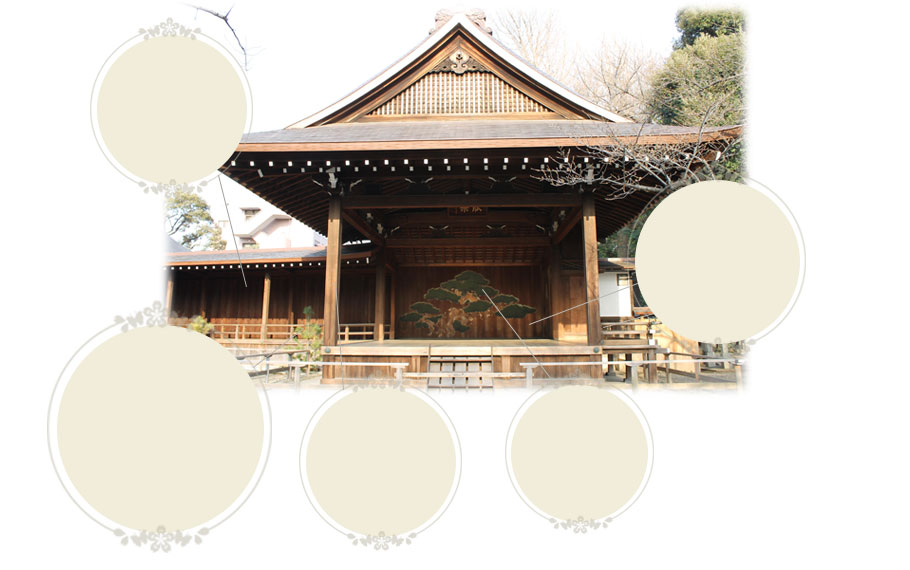
Hashigakari
The pass from left away side to the stage is called with this name. Normally it has 12 to 15 meters.
Pine trees of Hashigakari
Three pine trees planted on the pass “Hashigakari” Not only to use the laws of perspective. When the actor put a mask which is not possible to keep sight,
these trees helps to
grasp the position.
Pillar
The stage which is surrounded with four pillars is the main stage. It says these four pillars expressing four seasons and four directions.
Kagami-ita
The back wall of the main stage draws an old pine tree.
Kyoto Takigino
Right and back extra space of the main stage is for music players and supporter for preparation of the stage.

Kyoto Takigino
This reminds one of an early summer season of Kyoto.
Since 1950, as an annual event of June in Heianjingu, the event has started.
When the area start to be dark, torches fire and the stage of the shrine will light up with glorious atmosphere.
The event is able to enjoy three major persuasions at one time which are almost impossible to realize except here.
About two thousand people visit to watch the stage every year.

